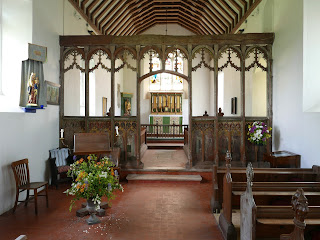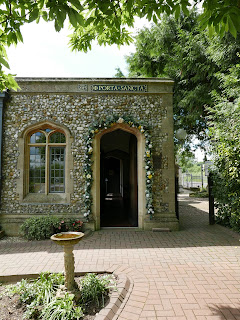The same signpost points to 'The Shrine, OLW', which made me recall that nearby, and on my way, were the Walsinghams, Little (the larger) and Great (the smaller). And that Little Walsingham was a pilgrimage centre famed throughout Europe in Medieval times, for it had The Shrine of Our Lady of Walsingham. Pilgrims came in their thousands from far away to see and marvel and achieve a state of grace.
If I sound touched by religious zeal myself, be disabused of that notion. By any standard, I am not a believer, nor ever have been. I have no religious family background, and have never been idealistic enough to voluntarily adopt a faith and run with it. There has never seemed to be any compelling need or reason to do that. And I noticed early on that although the embracing of a faith was psychologically comforting and sustaining to many people, and (at least in the Christian tradition) helped them develop compassion and selflessness and other good things, all the prayers in the world never prevented natural disasters, nor dire man-made ones. So to me religion was for people who hoped for an idealised life beyond death in a place called heaven, and meanwhile were content to accept a ready-made set of rules for living, all worked out for them to follow. Something certain and authoritative to hold on to, and even cherish. It was therefore unsuitable for those who preferred to formulate their own notions, based on their own personal life experiences. Thus it wasn't for me.
And yet I am certainly not what you might call a 'dogmatic disbeliever'. I think there is still an immense amount to discover about the entirely natural and invisible forces that exert an influence on living things, and what the mind itself can do. And I think it's wrong to disregard and disrespect ways of thought that, at their very heart, have a direct and primeval appeal to human nature. I go along with the idea that behind the texts and teachings, the stories and instructions, the rituals and images, and all the doctrinal encrustations of centuries, lies something worth knowing about what makes human beings tick. So I can visit a holy place as a woman with an interest in history and human psychology, if nothing more. Especially if the light is right, I have it to myself, and the place yearns to be photographed!
It was the cloud of pretty poppies by the road at Houghton St Giles (or is it really Houghton-in-the-Dale?) that first made me break my journey to Wells.
Surely the epitome of a modest English country church! And inside, some special features: a painted screen, for instance:
There were additional clues that this was a high Anglican church, in which the worship was led by a priest, not a vicar. There were also richly-painted images.
I left as discreetly as I had entered. There was 'To the Shrine OLW' on the signpost. It was nearby. Why not take a quick look?
So I found myself on a narrow lane that brought me to the Catholic National Shrine of Our Lady of Walsingham, a religious complex for pilgrims set in peaceful countryside to the south of Little Walsingham. At this point I thought this was the Shrine, and in a sense it was indeed - for Catholics - but it had its Anglican compliment in the village itself. That's for the next post, however. The Catholic Shrine consisted of two major buildings: a large modern one for Holy Communion, and a much, much older restored Slipper Chapel with a Holy Door, for pilgrims who wished to make a personal Petition to the Lady. Between them both, peaceful lawns, trees, shady walkways, and plenty of seating, all ideal for the faithful who clearly came by the coachload.
There were also plenty of more traditional boards, explaining the history and precise function of each part of the complex, and what the day's experience offered the pilgrim seeking a Spiritual Pathway to grace:
The steps to take were all set out. If you believed, how could you not come away spiritually refreshed?
The complex included a restaurant, and a place to get Holy Water:
The Holy Communion was still going on. There was an office containing staff, but I was out of their line of sight. I was effectively alone and unobserved. But I wasn't fully at ease by any means. I didn't belong here. I was an intruder. It had seemed mildly inappropriate, as a non-Catholic and non-believer, to simply wander about taking the odd photo. I had so far got away with it because I was older, female, and was behaving demurely. Now I was approaching the entrance to the Slipper Chapel. The sensation of trespassing was getting much more intense.
And then the Porta Sancta, the Holy Door itself.
I hesitated to enter. Almost on cue, a TV screen on a nearby wall caught my eye. It asked me So, why are you here?
Well, why was I here? I was drawn by sheer curiosity to see what lay within, whatever devout Catholics would see, and perhaps to understand what they did inside. And yet without being such a person myself. And wanting only to secure visual souvenirs - mere photos. I wasn't going to worship, nor pray, nor ask for legitimate spiritual intervention. It seemed positively sacrilegious.
If I went in, and encountered a priest, or a nun, what could I possibly say? I had no proper excuse, only an inconsequential personal reason that didn't amount to a pinch of dust. Despite Pope Francis decreeing this as a Year of Mercy, I would surely be shown none. The sins against me would be beyond redemption: the sins of Wanting To Know, and Taking Without Giving Back.
Yes or no? The opportunity might never recur. In I went. There was no frisson of electricity as I passed through the Holy Door. No alarm bells or klaxons. No sirens. No disturbance in The Force. Just silence. On the wall, a first stop for any pilgrim. A chance to pray before Jesus, with two little cardinals helping:
Then a corner, and a corridor. Still no challenge. I had the Slipper Chapel to myself. I came across what seemed to be the lesser of two chambers in the Chapel, rather plain and routine:
Would the pilgrim prepare himself or herself here, with a preliminary reading and a prayer? Along the corridor again, passing a ceramic nativity scene. Nearly now at the heart of the Chapel.
And then the main chamber, with the Altar, and Lady Mary, and the baby Jesus, to contemplate:
The flowers were freshly arranged, and the candles were lit. There was a while yet to go before the 2.30pm Rosary service; but at any moment someone might come in to make sure all was ready. I could not stay long. I felt extraordinarily furtive and dishonest, entering this place as an outsider. Guilt and shame would have paralysed me if I'd heard footsteps, and was found in the act of using my camera. But no such sounds came. I took these photos and baled out fast.
It was a relief to pass through the Holy Door once again, still unnoticed. I saw that I need not exit the way I'd come in. I could simply walk around the back of the Slipper Chapel, and thence to the car park. It was certainly Mission Accomplished. But at the same time I felt like a thief.
Driving away down the lane, I noticed a sideways track leading down to a deep ford across the River Stiffkey. He leadeth me beside the still waters. He restoreth my soul. I parked Fiona, walked down to the footbridge, and let the gently gurgling water restore my equanimity and my usual debonair demeanour. Judge for yourself:
At length I fired up Fiona again, and we headed into Little Walsingham. That was a strange experience too. Next post.









































